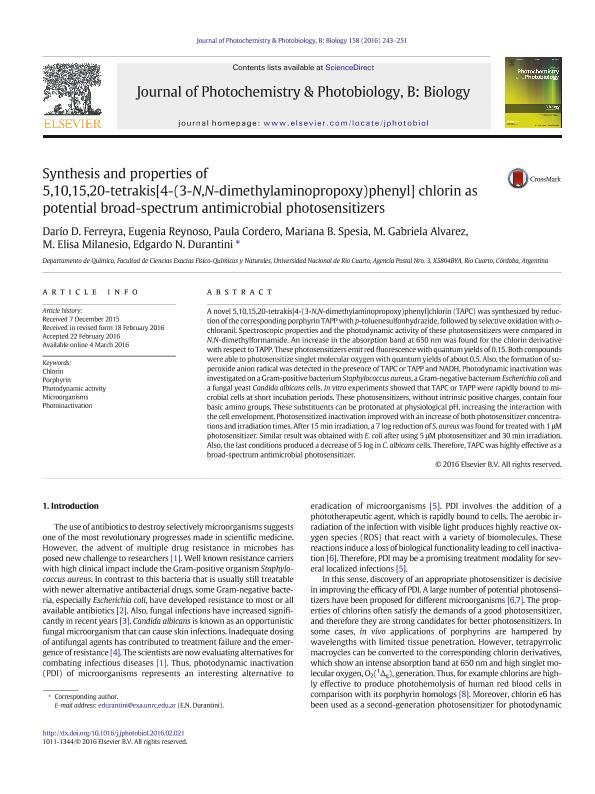Artículo
Synthesis and properties of 5,10,15,20-tetrakis[4-(3-N,N-dimethylaminopropoxy)phenyl] chlorin as potential broad-spectrum antimicrobial photosensitizers
Ferreyra, Darío David ; Reynoso, Eugenia
; Reynoso, Eugenia ; Cordero Gabrielli, Paula Verónica
; Cordero Gabrielli, Paula Verónica ; Spesia, Mariana Belen
; Spesia, Mariana Belen ; Alvarez, María Gabriela
; Alvarez, María Gabriela ; Milanesio, María Elisa
; Milanesio, María Elisa ; Durantini, Edgardo Néstor
; Durantini, Edgardo Néstor
 ; Reynoso, Eugenia
; Reynoso, Eugenia ; Cordero Gabrielli, Paula Verónica
; Cordero Gabrielli, Paula Verónica ; Spesia, Mariana Belen
; Spesia, Mariana Belen ; Alvarez, María Gabriela
; Alvarez, María Gabriela ; Milanesio, María Elisa
; Milanesio, María Elisa ; Durantini, Edgardo Néstor
; Durantini, Edgardo Néstor
Fecha de publicación:
05/2016
Editorial:
Elsevier Science Sa
Revista:
Journal of Photochemistry and Photobiology B: Biology
ISSN:
1011-1344
Idioma:
Inglés
Tipo de recurso:
Artículo publicado
Clasificación temática:
Resumen
A novel 5,10,15,20-tetrakis[4-(3-N,N-dimethylaminopropoxy)phenyl]chlorin (TAPC) was synthesized by reduction of the corresponding porphyrin TAPP with p-toluenesulfonhydrazide, followed by selective oxidation with o-chloranil. Spectroscopic properties and the photodynamic activity of these photosensitizers were compared in N,N-dimethylformamide. An increase in the absorption band at 650 nm was found for the chlorin derivative with respect to TAPP. These photosensitizers emit red fluorescence with quantum yields of 0.15. Both compounds were able to photosensitize singlet molecular oxygen with quantum yields of about 0.5. Also, the formation of superoxide anion radical was detected in the presence of TAPC or TAPP and NADH. Photodynamic inactivation was investigated on a Gram-positive bacterium Staphylococcus aureus, a Gram-negative bacterium Escherichia coli and a fungal yeast Candida albicans cells. In vitro experiments showed that TAPC or TAPP were rapidly bound to microbial cells at short incubation periods. These photosensitizers, without intrinsic positive charges, contain four basic amino groups. These substituents can be protonated at physiological pH, increasing the interaction with the cell envelopment. Photosensitized inactivation improved with an increase of both photosensitizer concentrations and irradiation times. After 15 min irradiation, a 7 log reduction of S. aureus was found for treated with 1 μM photosensitizer. Similar result was obtained with E. coli after using 5 μM photosensitizer and 30 min irradiation. Also, the last conditions produced a decrease of 5 log in C. albicans cells. Therefore, TAPC was highly effective as a broad-spectrum antimicrobial photosensitizer.
Palabras clave:
Chlorin
,
Microorganisms
,
Photodynamic Activity
,
Photoinactivation
,
Porphyrin
Archivos asociados
Licencia
Identificadores
Colecciones
Articulos(CCT - CORDOBA)
Articulos de CTRO.CIENTIFICO TECNOL.CONICET - CORDOBA
Articulos de CTRO.CIENTIFICO TECNOL.CONICET - CORDOBA
Articulos(INIFTA)
Articulos de INST.DE INV.FISICOQUIMICAS TEORICAS Y APLIC.
Articulos de INST.DE INV.FISICOQUIMICAS TEORICAS Y APLIC.
Citación
Ferreyra, Darío David; Reynoso, Eugenia; Cordero Gabrielli, Paula Verónica; Spesia, Mariana Belen; Alvarez, María Gabriela; et al.; Synthesis and properties of 5,10,15,20-tetrakis[4-(3-N,N-dimethylaminopropoxy)phenyl] chlorin as potential broad-spectrum antimicrobial photosensitizers; Elsevier Science Sa; Journal of Photochemistry and Photobiology B: Biology; 158; 5-2016; 243-251
Compartir
Altmétricas



